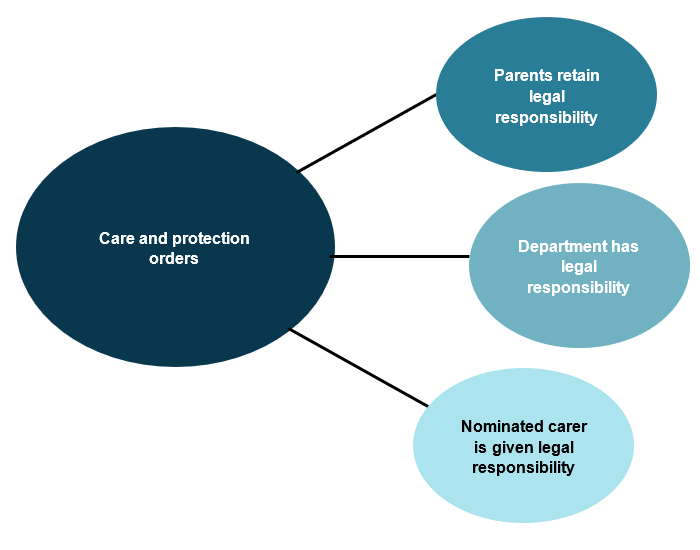Care and protection orders
Key findings
- Around 61,700 children were on care and protection orders at 30 June 2021.
- Of the children on care and protection orders, 39% (24,200 or 71 per 1,000) were Indigenous.
- Of the 12,100 children admitted to orders in 2020–21, 9,200 (76%) were admitted for the first time.
- 11,800 children were discharged from care and protection orders in 2020–21.
What is a care and protection order?
Care and protection orders are legal orders or arrangements that give child protection departments partial or full responsibility for a child’s welfare (see Table 4.1 for further information). Children are placed on care and protection orders if they are at a serious risk of harm or there are no other care options.
Figure 4.1 outlines the 3 main categories of legal responsibility conferred by care and protection orders.
Figure 4.1: Legal responsibility conferred by care and protection orders

Chart: AIHW.
Children might be admitted (or re-admitted) to a care and protection order for various reasons, including substantiated abuse, irretrievable breakdown in the relationship between the child and their parents, or where parents are unwilling and/or unable to adequately care for the child.
A substantiated notification of abuse or neglect does not necessarily mean that a child will be placed on a care and protection order. If the child’s parents are prepared to, or have made changes to ensure the child’s safety and wellbeing at home, then the department may decide an order is unnecessary and either refer the family to support services, put a safety plan in place, or determine that no further action is needed.
Nationally, 23% of children who were the subjects of substantiations in 2019–20 were subsequently placed on a care and protection order within 12 months (Supplementary table S4.2).
| Order type | Who has legal responsibility for the child? |
When is this type of order used? |
Who has day-to-day responsibility for care of the child? |
Duration |
|---|---|---|---|---|
| Guardianship order | State or territory child protection department or non-government agency | When a child is in an unsafe environment and at risk of further harm | Nominated carer | Short-term and long-term |
| Custody order | Child’s parents retain legal guardianship when child is in the custody of a state or territory child protection department or non-government agency | When a child is in an unsafe environment and at risk of further harm | Child protection department or non-government agency | Short-term and long-term |
| Third-party parental responsibility order | Nominated individual approved by the courts | Parents are not providing care and a stable or permanent placement is made | Nominated carer | Short-term and long-term |
| Supervisory order | Child’s parents (under supervision and/or guidance of child protection department) | When parents require support or guidance to provide suitable care to their child | Parents (under supervision and/or guidance of child protection department) | Short-term and long-term |
| Interim and temporary order | Child’s parents or state or territory child protection department | Temporary care to remove a child from an unsafe environment usually occurs while another type of order is being sought | Child’s parents or state or territory child protection department | Short-term |
| Administrative arrangement | State or territory child protection department or non-government agency | Emergency situations where children require immediate removal from an unsafe environment | Child protection department or a nominated carer | Short-term and long-term |
| Immigration order | Minister for Immigration or nominated carer | When children enter Australia without a relative to care for them | Child protection department or a nominated carer | Short-term |
Box 4.1 outlines data limitations for reporting on children on care and protection orders.
Box 4.1: Data limitations for children on care and protection orders
A number of considerations with data related to children on care and protection orders need to be taken into account; some notable issues include:
- Some outputs are not comparable across jurisdictions due to differences in the way jurisdictions collect and report data on notifications, investigations and substantiations, and living arrangements.
- There are some differences in order types across jurisdictions. See Child protection Australia 2018–19, Appendix G for the most recent mapping of local order types to national reporting categories.
- New South Wales order data do not include children on finalised supervisory orders and currently do not strictly conform to the national counting rules for admissions to care and protection orders.
- Due to issues with the recording of order status, Tasmanian data for care and protection orders should be interpreted with caution.


